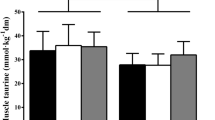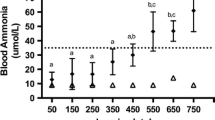Abstract
Carnosine (β-alanyl-l-histidine) is found in high concentrations in skeletal muscle and chronic β-alanine (BA) supplementation can increase carnosine content. This placebo-controlled, double-blind study compared two different 8-week BA dosing regimens on the time course of muscle carnosine loading and 8-week washout, leading to a BA dose–response study with serial muscle carnosine assessments throughout. Thirty-one young males were randomized into three BA dosing groups: (1) high–low: 3.2 g BA/day for 4 weeks, followed by 1.6 g BA/day for 4 weeks; (2) low–low: 1.6 g BA/day for 8 weeks; and (3) placebo. Muscle carnosine in tibialis-anterior (TA) and gastrocnemius (GA) muscles was measured by 1H-MRS at weeks 0, 2, 4, 8, 12 and 16. Flushing symptoms and blood clinical chemistry were trivial in all three groups and there were no muscle carnosine changes in the placebo group. During the first 4 weeks, the increase for high–low (TA 2.04 mmol/kgww, GA 1.75 mmol/kgww) was ~twofold greater than low–low (TA 1.12 mmol/kgww, GA 0.80 mmol/kgww). 1.6 g BA/day significantly increased muscle carnosine within 2 weeks and induced continual rises in already augmented muscle carnosine stores (week 4–8, high–low regime). The dose–response showed a carnosine increase of 2.01 mmol/kgww per 100 g of consumed BA, which was only dependent upon the total accumulated BA consumed (within a daily intake range of 1.6–3.2 g BA/day). Washout rates were gradual (0.18 mmol/kgww and 0.43 mmol/kgww/week; ~2%/week). In summary, the absolute increase in muscle carnosine is only dependent upon the total BA consumed and is not dependent upon baseline muscle carnosine, the muscle type, or the daily amount of supplemented BA.





Similar content being viewed by others
References
Abe H (2000) Role of histidine-related compounds as intracellular proton buffering constituents in vertebrate muscle. Biochemistry (Mosc) 65:757–765
Albani C, Blaser G, Geyer M, Schmutzer G, Brähler E, Bailer H et al (2005) Überprüfung der Gütekriterien der deutschen Kurzform des Fragebogens “Profile of Mood States” (POMS) in einer repräsentativen Bevolkerungsstichprobe. Psychother Psychiatr Med 55:324–330
Artioli GG, Gualano B, Smith A, Stout J, Lancha AH Jr (2010) Role of beta-alanine supplementation on muscle carnosine and exercise performance. Med Sci Sports Exerc 42:1162–1173
Asatoor AM, Bandoh JK, Lant AF, Milne MD, Navab F (1970) Intestinal absorption of carnosine and its constituent amino acids in man. Gut 11:250–254
Baguet A, Reyngoudt H, Pottier A, Everaert I, Callens S, Achten E et al (2009) Carnosine loading and washout in human skeletal muscles. J Appl Physiol 106:837–842
Baguet A, Bourgois J, Vanhee L, Achten E, Derave W (2010a) Important role of muscle carnosine in rowing performance. J Appl Physiol 109:1096–1101
Baguet A, Koppo K, Pottier A, Derave W (2010b) Beta-alanine supplementation reduces acidosis but not oxygen uptake response during high-intensity cycling exercise. Eur J Appl Physiol 108:495–503
Bakardjiev A, Bauer K (1994) Transport of beta-alanine and biosynthesis of carnosine by skeletal muscle cells in primary culture. Eur J Biochem 225:617–623
Bate-Smith EC (1938) The buffering of muscle in rigor: protein, phosphate and carnosine. J Physiol 92:336–343
Batrukova MA, Rubtsov AM (1997) Histidine-containing dipeptides as endogenous regulators of the activity of sarcoplasmic reticulum Ca-release channels. Biochim Biophys Acta 1324:142–150
Boesch C, Kreis R (2001) Dipolar coupling and ordering effects observed in magnetic resonance spectra of skeletal muscle. NMR Biomed 14:140–148
Boldyrev AA, Koldobski A, Kurella E, Maltseva V, Stvolinski S (1993) Natural histidine-containing dipeptide carnosine as a potent hydrophilic antioxidant with membrane stabilizing function. A biomedical aspect. Mol Chem Neuropathol 19:185–192
Decombaz J, Beaumont M, Vuichoud J, Bouisset F, Enslen M, Stellingwerff T (2011) The effect of slow-release β-alanine on absorption kinetics and paresthesia (abstract). Med Sci Sports Exerc 43:S2224
Derave W, Ozdemir MS, Harris RC, Pottier A, Reyngoudt H, Koppo K et al (2007) β-Alanine supplementation augments muscle carnosine content and attenuates fatigue during repeated isokinetic contraction bouts in trained sprinters. J Appl Physiol 103:1736–1743
Derave W, Everaert I, Beeckman S, Baguet A (2010) Muscle carnosine metabolism and beta-alanine supplementation in relation to exercise and training. Sports Med 40:247–263
Dunnett M, Harris RC (1995) Carnosine and taurine contents of different fibre types in the middle gluteal muscle of the thoroughbred horse. Equine Vet J S18:214–217
Everaert I, Mooyaart A, Baguet A, Zutinic A, Baelde H, Achten E et al (2011) Vegetarianism, female gender and increasing age, but not CNDP1 genotype, are associated with reduced muscle carnosine levels in humans. Amino Acids 40:1221–1229
Flancbaum L, Fitzpatrick JC, Brotman DN, Marcoux AM, Kasziba E, Fisher H (1990) The presence and significance of carnosine in histamine-containing tissues of several mammalian species. Agents Actions 31:190–196
Harris RC, Soderlund K, Hultman E (1992) Elevation of creatine in resting and exercised muscle of normal subjects by creatine supplementation. Clin Sci 8:367–374
Harris RC, Tallon MJ, Dunnett M, Boobis L, Coakley J, Kim HJ et al (2006) The absorption of orally supplied beta-alanine and its effect on muscle carnosine synthesis in human vastus lateralis. Amino Acids 30:279–289
Harris RC, Jones GA, Wise JA (2008) The plasma concentration-time profile of beta-alanine using a controlled-release formulation (Carnosyn) (abstract). FASEB J 22:701.9
Hill CA, Harris RC, Kim HJ, Harris BD, Sale C, Boobis LH et al (2007) Influence of beta-alanine supplementation on skeletal muscle carnosine concentrations and high intensity cycling capacity. Amino Acids 32:225–233
Hipkiss AR (2005) Glycation, ageing and carnosine: are carnivorous diets beneficial? Mech Ageing Dev 126:1034–1039
Hoffman J, Ratamess N, Kang J, Mangine G, Faigenbaum A, Stout J (2006) Effect of creatine and beta-alanine supplementation on performance and endocrine responses in strength/power athletes. Int J Sport Nutr Exerc Metab 16:430–446
Hultman E, Soderlund K, Timmons JA, Cederblad G, Greenhaff PL (1996) Muscle creatine loading in men. J Appl Physiol 81:232–237
Kendrick IP, Harris RC, Kim HJ, Kim CK, Dang VH, Lam TQ et al (2008) The effects of 10 weeks of resistance training combined with beta-alanine supplementation on whole body strength, force production, muscular endurance and body composition. Amino Acids 34:547–554
Kendrick IP, Kim HJ, Harris RC, Kim CK, Dang VH, Lamb TQ et al (2009) The effect of 4 weeks beta-alanine supplementation and isokinetic training on carnosine concentrations in type I and II human skeletal muscle fibres. Eur J Appl Physiol 106:131–138
Kley RA, Tarnopolsky MA, Vorgerd M (2011) Creatine for treating muscle disorders. Cochrane Database Syst Rev 2:CD004760
Naressi A, Couturier C, Devos JM, Janssen M, Mangeat C, de Beer R et al (2001) Java-based graphical user interface for the MRUI quantitation package. Magma 12:141–152
Ozdemir MS, Reyngoudt H, De Deene Y, Sazak HS, Fieremans E, Delputte S et al (2007) Absolute quantification of carnosine in human calf muscle by proton magnetic resonance spectroscopy. Phys Med Biol 52:6781–6794
Park YJ, Volpe SL, Decker EA (2005) Quantitation of carnosine in humans plasma after dietary consumption of beef. J Agric Food Chem 53:4736–4739
Parkhouse WS, McKenzie DC (1984) Possible contribution of skeletal muscle buffers to enhanced anaerobic performance: a brief review. Med Sci Sports Exerc 16:328–338
Sale C, Saunders B, Harris RC (2010) Effect of beta-alanine supplementation on muscle carnosine concentrations and exercise performance. Amino Acids 39:321–333
Sale C, Saunders B, Hudson S, Wise JA, Harris RC, Sunderland CD (2011) Effect of beta-alanine plus sodium bicarbonate on high-intensity cycling capacity. Med Sci Sports Exerc. doi:10.1249/MSS.0b013e3182188501
Schroder L, Bachert P (2003) Evidence for a dipolar-coupled AM system in carnosine in human calf muscle from in vivo 1H NMR spectroscopy. J Magn Reson 164:256–269
Shacham S (1983) A shortened version of the profile of mood states. J Pers Assess 47:305–306
Shen Y, Zhang S, Fu L, Hu W, Chen Z (2008) Carnosine attenuates mast cell degranulation and histamine release induced by oxygen-glucose deprivation. Cell Biochem Funct 26:334–338
Spielberger CD, Gorsuch RL, Lushene PR, Vagg PR, Jacobs AG (1983) Manual for the state-trait anxiety inventory (Form Y). Consulting Psychologists Press Inc., Palo Alto, CA, p 36
Stout JR, Cramer JT, Mielke M, O’Kroy J, Torok DJ, Zoeller RF (2006) Effects of twenty-eight days of beta-alanine and creatine monohydrate supplementation on the physical working capacity at neuromuscular fatigue threshold. J Strength Cond Res 20:928–931
Zoeller RF, Stout JR, O’Kroy JA, Torok DJ, Mielke M (2007) Effects of 28 days of beta-alanine and creatine monohydrate supplementation on aerobic power, ventilatory and lactate thresholds, and time to exhaustion. Amino Acids 33:505–510
Acknowledgments
This study was supported by Nestec Ltd., Vevey, Switzerland and from the Swiss National Science Foundation (#310000-118219). Special acknowledgement go to: Andreas Boss for study support and assistance; Regula Koenig for MR-data analysis assistance; Laurent Parmentier for dermatological tests; Jacques Vuichoud for analytical support in measuring β-alanine in the supplements; Dominik Grathwohl for statistical advice; and Corina Boschat for blinding and preparation of supplements. Some of the authors (TS, JD) are employees of Nestec Ltd, which is a subsidiary of Nestlé Ltd. and provides professional assistance, research, and consulting services for food, dietary, dietetic, and pharmaceutical products of interest to Nestlé Ltd. No other conflicts of interest were reported.
Author information
Authors and Affiliations
Corresponding author
Rights and permissions
About this article
Cite this article
Stellingwerff, T., Anwander, H., Egger, A. et al. Effect of two β-alanine dosing protocols on muscle carnosine synthesis and washout. Amino Acids 42, 2461–2472 (2012). https://doi.org/10.1007/s00726-011-1054-4
Received:
Accepted:
Published:
Issue Date:
DOI: https://doi.org/10.1007/s00726-011-1054-4




